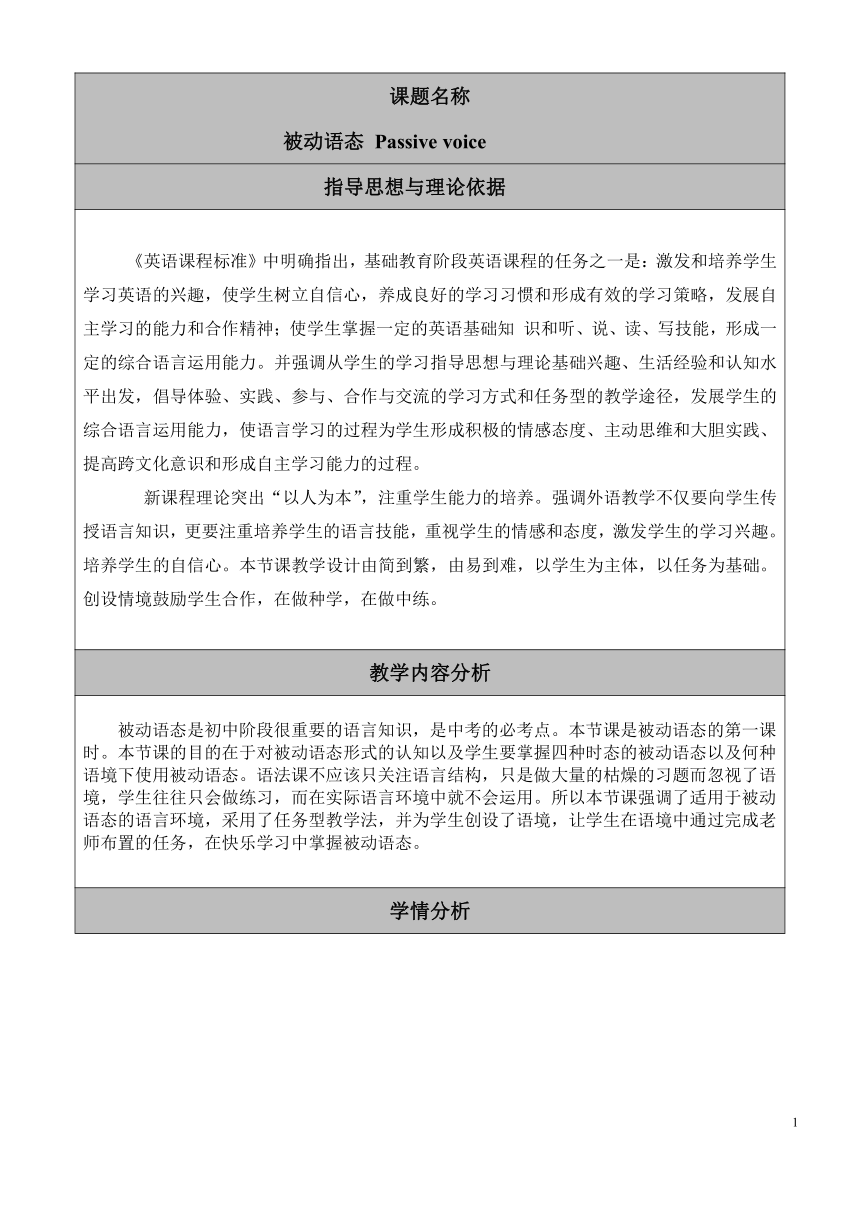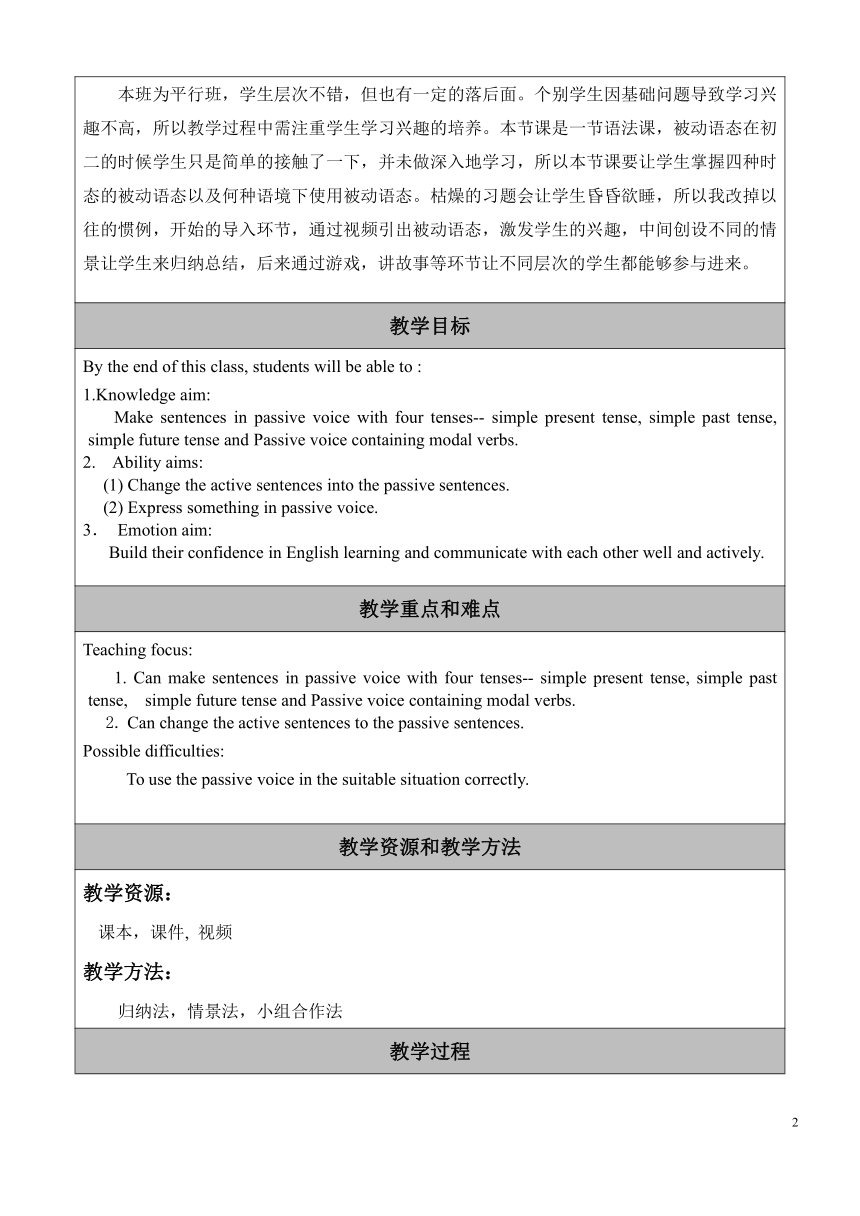外研版九年级上册 Module 9 unit2 Will books be replaced by the Internet?教案
文档属性
| 名称 | 外研版九年级上册 Module 9 unit2 Will books be replaced by the Internet?教案 |  | |
| 格式 | doc | ||
| 文件大小 | 69.5KB | ||
| 资源类型 | 教案 | ||
| 版本资源 | 外研版 | ||
| 科目 | 英语 | ||
| 更新时间 | 2020-09-30 16:34:24 | ||
图片预览


文档简介
课题名称 被动语态 Passive voice
指导思想与理论依据
《英语课程标准》中明确指出,基础教育阶段英语课程的任务之一是:激发和培养学生学习英语的兴趣,使学生树立自信心,养成良好的学习习惯和形成有效的学习策略,发展自主学习的能力和合作精神;使学生掌握一定的英语基础知 识和听、说、读、写技能,形成一定的综合语言运用能力。并强调从学生的学习指导思想与理论基础兴趣、生活经验和认知水平出发,倡导体验、实践、参与、合作与交流的学习方式和任务型的教学途径,发展学生的综合语言运用能力,使语言学习的过程为学生形成积极的情感态度、主动思维和大胆实践、提高跨文化意识和形成自主学习能力的过程。
新课程理论突出“以人为本”,注重学生能力的培养。强调外语教学不仅要向学生传授语言知识,更要注重培养学生的语言技能,重视学生的情感和态度,激发学生的学习兴趣。培养学生的自信心。本节课教学设计由简到繁,由易到难,以学生为主体,以任务为基础。创设情境鼓励学生合作,在做种学,在做中练。
教学内容分析
被动语态是初中阶段很重要的语言知识,是中考的必考点。本节课是被动语态的第一课时。本节课的目的在于对被动语态形式的认知以及学生要掌握四种时态的被动语态以及何种语境下使用被动语态。语法课不应该只关注语言结构,只是做大量的枯燥的习题而忽视了语境,学生往往只会做练习,而在实际语言环境中就不会运用。所以本节课强调了适用于被动语态的语言环境,采用了任务型教学法,并为学生创设了语境,让学生在语境中通过完成老师布置的任务,在快乐学习中掌握被动语态。
学情分析
本班为平行班,学生层次不错,但也有一定的落后面。个别学生因基础问题导致学习兴趣不高,所以教学过程中需注重学生学习兴趣的培养。本节课是一节语法课,被动语态在初二的时候学生只是简单的接触了一下,并未做深入地学习,所以本节课要让学生掌握四种时态的被动语态以及何种语境下使用被动语态。枯燥的习题会让学生昏昏欲睡,所以我改掉以往的惯例,开始的导入环节,通过视频引出被动语态,激发学生的兴趣,中间创设不同的情景让学生来归纳总结,后来通过游戏,讲故事等环节让不同层次的学生都能够参与进来。
教学目标
By the end of this class, students will be able to : 1.Knowledge aim:
Make sentences in passive voice with four tenses-- simple present tense, simple past tense, simple future tense and Passive voice containing modal verbs.
2. Ability aims:
(1) Change the active sentences into the passive sentences.
(2) Express something in passive voice.
3. Emotion aim:
Build their confidence in English learning and communicate with each other well and actively.
教学重点和难点
Teaching focus: 1. Can make sentences in passive voice with four tenses-- simple present tense, simple past tense, simple future tense and Passive voice containing modal verbs.
2. Can change the active sentences to the passive sentences.
Possible difficulties:
To use the passive voice in the suitable situation correctly.
教学资源和教学方法
教学资源: 课本,课件, 视频
教学方法:
归纳法,情景法,小组合作法
教学过程
教学环节 Step 1.
Lead- in 教师活动
Show a video about beaten Doudou. 学生活动
Ss watch the video. 设计意图
Open the students mind, let students feel passive voice. 时间
安排
1’
Step 2. Observe and summarize
1
Passive voice in present tense Show some pictures to Ss
and let them observe the sentences. ①look at the sentences and say ②summarize the passive voice in simple present tense.
③ practice:
group A—group B
Prepare for understanding passive voice 3’
2. Passive voice in past tense Show four pictures and ask Ss to say the sentences with passive voice.
① watch the sentences
②summarize the passive voice in simple past tense
③practice with the partner.
Understand passive voice 4’
3. Passive voice in future tense First, ask Ss to read the sentences and summarize. ①Watch
②summarize
③practice in a group Let Ss know passive voice simple future. 4’
4. Passive voice containing modal verbs.
Show some pictures and sentences, and let Ss say the structures. ①say the sentences
②summarize the passive voice containing modal verbs
③practice by talking freely Help Ss to understand passive voice containing modal verbs.
3’
Step 3 Practice
Create some situations to practice passive voice.
According to the situations, talk about in different ways. Help Ss learn how to use passive voice. 8’
Step4 Practice
Play a game Ask Ss to choose golden eggs to finish tasks. First, Ss choose one egg; then, finish one task. Go over passive voice in a game. 6’
Step 5. Production
Tell a story First, show details
Second, talk about the story in a group.
Third, tell the story. First, show details
Second, talk about the story in a group.
Third, tell the story. Ss can not only learn the structures of passive voice, but also put it in a story to use. 7’
Step6. Production
Talk about school life Ask Ss to talk about their lives with passive voice Look and say it one by one or together. According to what they have learnt, Ss can tell their real life. 3’
Step 7 Homework Write a composition about students’ school life with passive voice After class, write a composition. They not only practice using the passive voice, but also learn to share with others. 1’
板书设计
Passive voice
simple present tense: am/is/are+ done
simple past tense: was/were+ done
simple future tense will be + done
containing modal verbs: modal verbs be+done
3
指导思想与理论依据
《英语课程标准》中明确指出,基础教育阶段英语课程的任务之一是:激发和培养学生学习英语的兴趣,使学生树立自信心,养成良好的学习习惯和形成有效的学习策略,发展自主学习的能力和合作精神;使学生掌握一定的英语基础知 识和听、说、读、写技能,形成一定的综合语言运用能力。并强调从学生的学习指导思想与理论基础兴趣、生活经验和认知水平出发,倡导体验、实践、参与、合作与交流的学习方式和任务型的教学途径,发展学生的综合语言运用能力,使语言学习的过程为学生形成积极的情感态度、主动思维和大胆实践、提高跨文化意识和形成自主学习能力的过程。
新课程理论突出“以人为本”,注重学生能力的培养。强调外语教学不仅要向学生传授语言知识,更要注重培养学生的语言技能,重视学生的情感和态度,激发学生的学习兴趣。培养学生的自信心。本节课教学设计由简到繁,由易到难,以学生为主体,以任务为基础。创设情境鼓励学生合作,在做种学,在做中练。
教学内容分析
被动语态是初中阶段很重要的语言知识,是中考的必考点。本节课是被动语态的第一课时。本节课的目的在于对被动语态形式的认知以及学生要掌握四种时态的被动语态以及何种语境下使用被动语态。语法课不应该只关注语言结构,只是做大量的枯燥的习题而忽视了语境,学生往往只会做练习,而在实际语言环境中就不会运用。所以本节课强调了适用于被动语态的语言环境,采用了任务型教学法,并为学生创设了语境,让学生在语境中通过完成老师布置的任务,在快乐学习中掌握被动语态。
学情分析
本班为平行班,学生层次不错,但也有一定的落后面。个别学生因基础问题导致学习兴趣不高,所以教学过程中需注重学生学习兴趣的培养。本节课是一节语法课,被动语态在初二的时候学生只是简单的接触了一下,并未做深入地学习,所以本节课要让学生掌握四种时态的被动语态以及何种语境下使用被动语态。枯燥的习题会让学生昏昏欲睡,所以我改掉以往的惯例,开始的导入环节,通过视频引出被动语态,激发学生的兴趣,中间创设不同的情景让学生来归纳总结,后来通过游戏,讲故事等环节让不同层次的学生都能够参与进来。
教学目标
By the end of this class, students will be able to : 1.Knowledge aim:
Make sentences in passive voice with four tenses-- simple present tense, simple past tense, simple future tense and Passive voice containing modal verbs.
2. Ability aims:
(1) Change the active sentences into the passive sentences.
(2) Express something in passive voice.
3. Emotion aim:
Build their confidence in English learning and communicate with each other well and actively.
教学重点和难点
Teaching focus: 1. Can make sentences in passive voice with four tenses-- simple present tense, simple past tense, simple future tense and Passive voice containing modal verbs.
2. Can change the active sentences to the passive sentences.
Possible difficulties:
To use the passive voice in the suitable situation correctly.
教学资源和教学方法
教学资源: 课本,课件, 视频
教学方法:
归纳法,情景法,小组合作法
教学过程
教学环节 Step 1.
Lead- in 教师活动
Show a video about beaten Doudou. 学生活动
Ss watch the video. 设计意图
Open the students mind, let students feel passive voice. 时间
安排
1’
Step 2. Observe and summarize
1
Passive voice in present tense Show some pictures to Ss
and let them observe the sentences. ①look at the sentences and say ②summarize the passive voice in simple present tense.
③ practice:
group A—group B
Prepare for understanding passive voice 3’
2. Passive voice in past tense Show four pictures and ask Ss to say the sentences with passive voice.
① watch the sentences
②summarize the passive voice in simple past tense
③practice with the partner.
Understand passive voice 4’
3. Passive voice in future tense First, ask Ss to read the sentences and summarize. ①Watch
②summarize
③practice in a group Let Ss know passive voice simple future. 4’
4. Passive voice containing modal verbs.
Show some pictures and sentences, and let Ss say the structures. ①say the sentences
②summarize the passive voice containing modal verbs
③practice by talking freely Help Ss to understand passive voice containing modal verbs.
3’
Step 3 Practice
Create some situations to practice passive voice.
According to the situations, talk about in different ways. Help Ss learn how to use passive voice. 8’
Step4 Practice
Play a game Ask Ss to choose golden eggs to finish tasks. First, Ss choose one egg; then, finish one task. Go over passive voice in a game. 6’
Step 5. Production
Tell a story First, show details
Second, talk about the story in a group.
Third, tell the story. First, show details
Second, talk about the story in a group.
Third, tell the story. Ss can not only learn the structures of passive voice, but also put it in a story to use. 7’
Step6. Production
Talk about school life Ask Ss to talk about their lives with passive voice Look and say it one by one or together. According to what they have learnt, Ss can tell their real life. 3’
Step 7 Homework Write a composition about students’ school life with passive voice After class, write a composition. They not only practice using the passive voice, but also learn to share with others. 1’
板书设计
Passive voice
simple present tense: am/is/are+ done
simple past tense: was/were+ done
simple future tense will be + done
containing modal verbs: modal verbs be+done
3
同课章节目录
- Module 1 Wonders of the world
- Unit 1 It's more than 2,000 years old.
- Unit 2 The Grand Canyon was not just big.
- Unit 3 Language in use
- Module 2 Public holidays
- Unit 1 My family always go somewhere interesting a
- Unit 2 We have celebrated the festival since the f
- Unit 3 Language in use
- Module 3 Heroes
- Unit 1 She trained hard,so she became a great play
- Unit 2There were few doctors, so he had to work ve
- Unit 3 Language in use
- Module 4 Home alone
- Unit 1 I can look after myself, although it won’t
- Unit 2 I became so bored with their orders that I
- Unit 3 Language in use
- Module 5 Museums
- Unit 1 Don't cross that rope!
- Unit 2 If you ever go to London, make sure you vis
- Unit 3 Language in use
- Module 6 Problems
- Unit 1 If I start after dinner, I'll finish it be
- Unit 2 If you tell him the truth now, you will sho
- Unit 3 Language in use
- Revision Module A
- Module 7 Great books
- Unit 1 We're still influenced by Confucius's idea
- Unit 2 It is still read and loved.
- Unit 3 Language in use
- Module 8 Sports life
- Unit 1 Daming wasn't chosen for the team last time
- Unit 2 He was invited to competitions around the w
- Unit 3 Language in use
- Module 9 Great inventions
- Unit 1 Will computers be used more than books in t
- Unit 2 Will books be replaced by the Internet?
- Unit 3 Language in use
- Module 10 Australia
- Unit 1 I have some photos that I took in Australia
- Unit 2 The game that they like most is Australian
- Unit 3 Language in use
- Module 11 Photos
- Unit 1 He's the boy who won the photo competition
- Unit 2 The photo which we liked best was taken by
- Unit 3 Language in use
- Module 12 Save our world
- Unit 1 If everyone starts to do something, the wor
- Unit 2 Repeat these three words daily: reduce, reu
- Unit 3 Language in use
- Revision Module B
